FORD C MAX 2011 2.G Owners Manual
Manufacturer: FORD, Model Year: 2011, Model line: C MAX, Model: FORD C MAX 2011 2.GPages: 296, PDF Size: 7.87 MB
Page 271 of 296
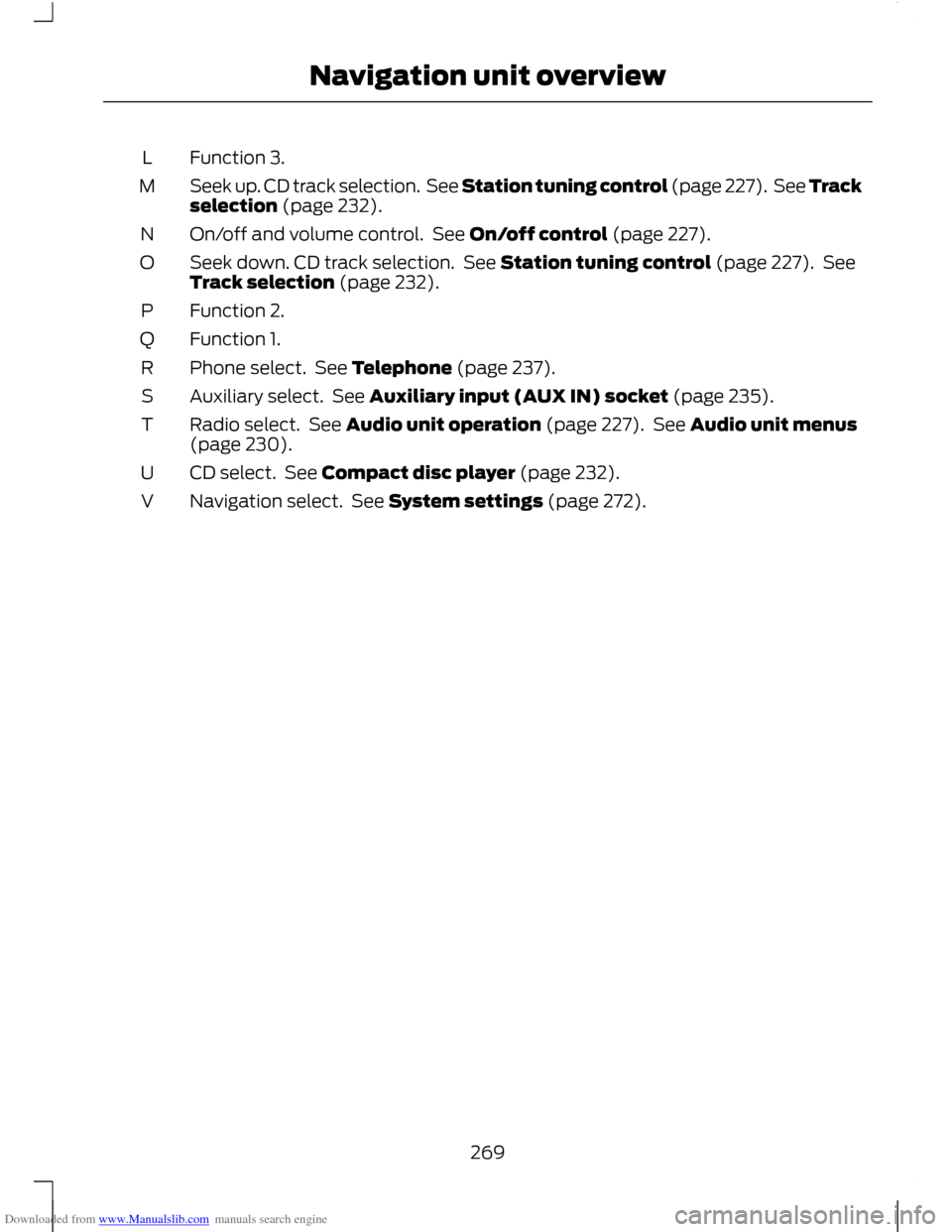
Downloaded from www.Manualslib.com manuals search engine Function 3.
L
Seek up. CD track selection. See Station tuning control (page 227). See Track
selection (page 232).
M
On/off and volume control. See On/off control (page 227).
N
Seek down. CD track selection. See Station tuning control (page 227). See
Track selection (page 232).
O
Function 2.
P
Function 1.
Q
Phone select. See Telephone (page 237).
R
Auxiliary select. See Auxiliary input (AUX IN) socket (page 235).
S
Radio select. See Audio unit operation (page 227). See Audio unit menus
(page 230).
T
CD select. See Compact disc player (page 232).
U
Navigation select. See System settings (page 272).
V
269
Navigation unit overview
Page 272 of 296
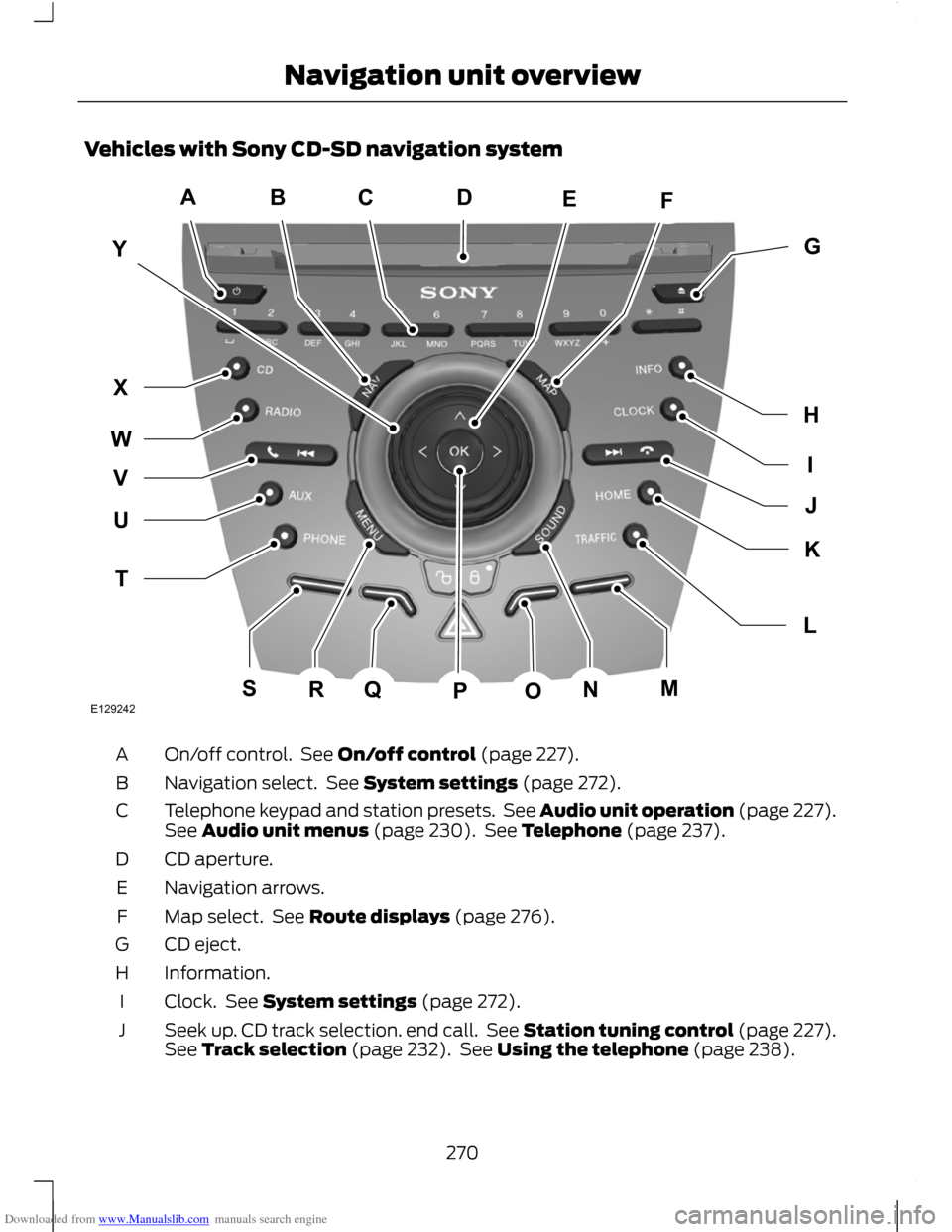
Downloaded from www.Manualslib.com manuals search engine Vehicles with Sony CD-SD navigation system
On/off control. See On/off control (page 227).
A
Navigation select. See System settings (page 272).
B
Telephone keypad and station presets. See Audio unit operation (page 227).
See Audio unit menus (page 230). See Telephone (page 237).
C
CD aperture.
D
Navigation arrows.
E
Map select. See Route displays (page 276).
F
CD eject.
G
Information.
H
Clock. See System settings (page 272).
I
Seek up. CD track selection. end call. See Station tuning control (page 227).
See Track selection (page 232). See Using the telephone (page 238).
J
270
Navigation unit overviewACBFEYIGHJLKTUWXVQSRNMOPDE129242
Page 273 of 296
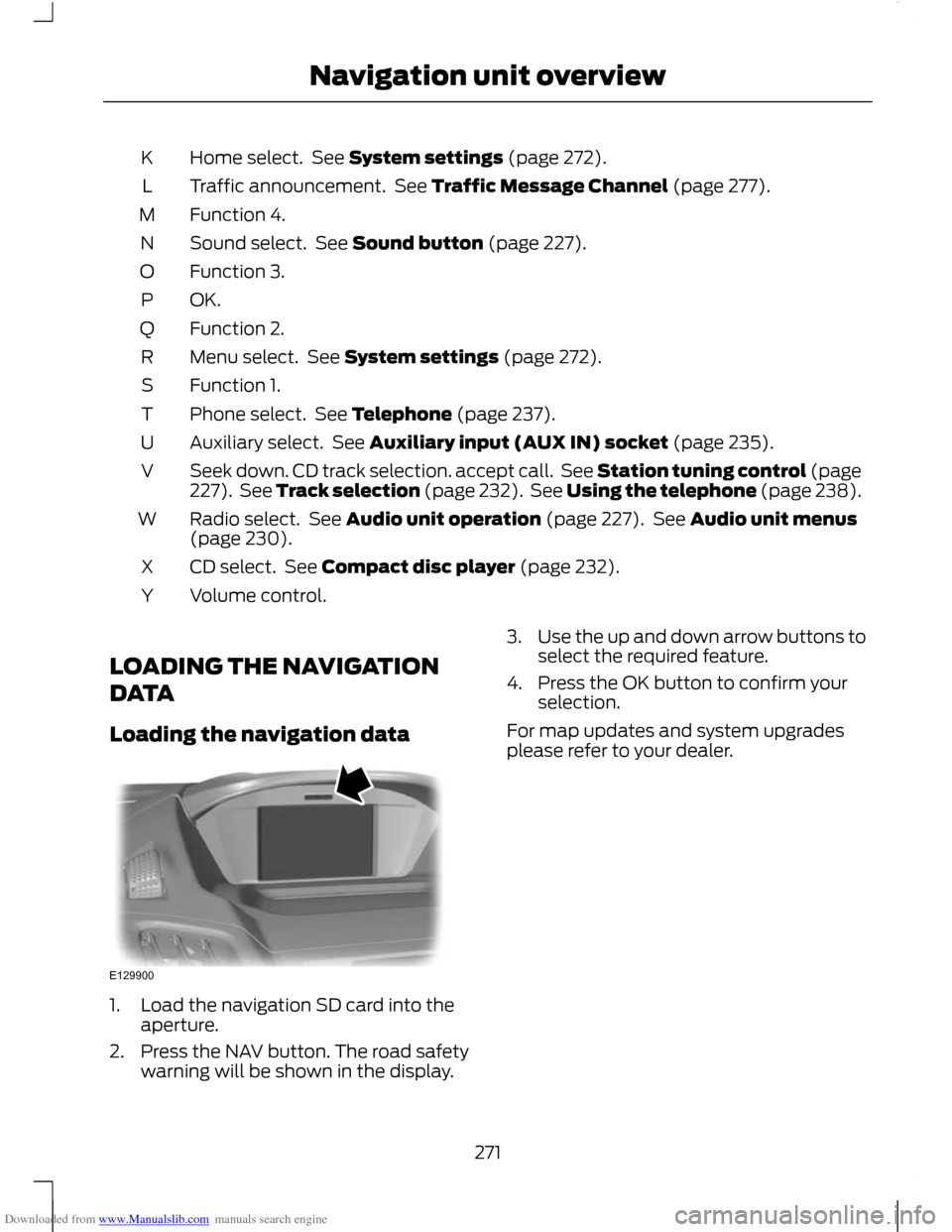
Downloaded from www.Manualslib.com manuals search engine Home select. See System settings (page 272).
K
Traffic announcement. See Traffic Message Channel (page 277).
L
Function 4.
M
Sound select. See Sound button (page 227).
N
Function 3.
O
OK.P
Function 2.
Q
Menu select. See System settings (page 272).
R
Function 1.
S
Phone select. See Telephone (page 237).
T
Auxiliary select. See Auxiliary input (AUX IN) socket (page 235).
U
Seek down. CD track selection. accept call. See Station tuning control (page
227). See Track selection (page 232). See Using the telephone (page 238).
V
Radio select. See Audio unit operation (page 227). See Audio unit menus
(page 230).
W
CD select. See Compact disc player (page 232).
X
Volume control.
Y
LOADING THE NAVIGATION
DATA
Loading the navigation data 1. Load the navigation SD card into the
aperture.
2. Press the NAV button. The road safety warning will be shown in the display. 3.
Use the up and down arrow buttons to
select the required feature.
4. Press the OK button to confirm your selection.
For map updates and system upgrades
please refer to your dealer.
271
Navigation unit overviewE129900
Page 274 of 296
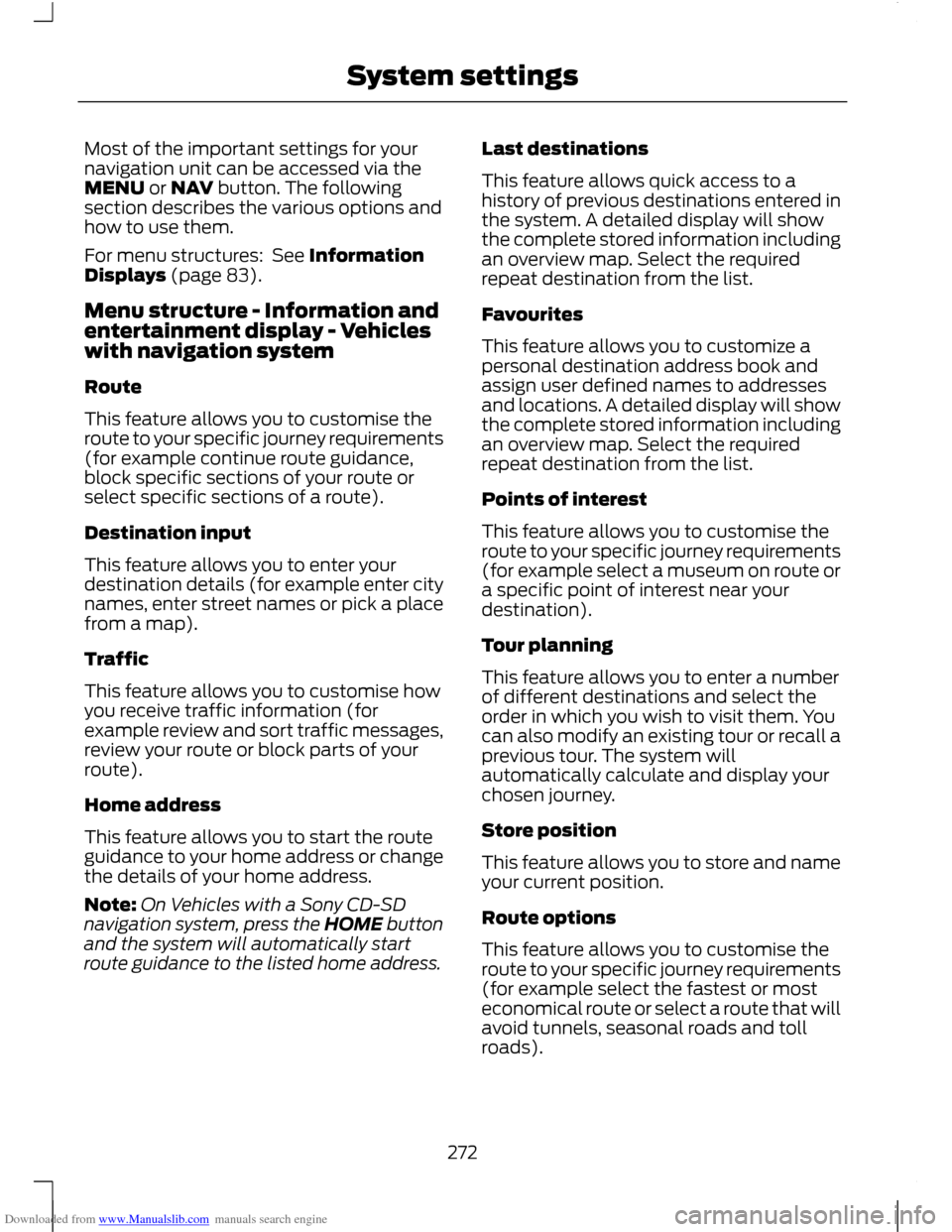
Downloaded from www.Manualslib.com manuals search engine Most of the important settings for your
navigation unit can be accessed via the
MENU or NAV button. The following
section describes the various options and
how to use them.
For menu structures: See Information
Displays (page 83).
Menu structure - Information and
entertainment display - Vehicles
with navigation system
Route
This feature allows you to customise the
route to your specific journey requirements
(for example continue route guidance,
block specific sections of your route or
select specific sections of a route).
Destination input
This feature allows you to enter your
destination details (for example enter city
names, enter street names or pick a place
from a map).
Traffic
This feature allows you to customise how
you receive traffic information (for
example review and sort traffic messages,
review your route or block parts of your
route).
Home address
This feature allows you to start the route
guidance to your home address or change
the details of your home address.
Note:
On Vehicles with a Sony CD-SD
navigation system, press the HOME button
and the system will automatically start
route guidance to the listed home address. Last destinations
This feature allows quick access to a
history of previous destinations entered in
the system. A detailed display will show
the complete stored information including
an overview map. Select the required
repeat destination from the list.
Favourites
This feature allows you to customize a
personal destination address book and
assign user defined names to addresses
and locations. A detailed display will show
the complete stored information including
an overview map. Select the required
repeat destination from the list.
Points of interest
This feature allows you to customise the
route to your specific journey requirements
(for example select a museum on route or
a specific point of interest near your
destination).
Tour planning
This feature allows you to enter a number
of different destinations and select the
order in which you wish to visit them. You
can also modify an existing tour or recall a
previous tour. The system will
automatically calculate and display your
chosen journey.
Store position
This feature allows you to store and name
your current position.
Route options
This feature allows you to customise the
route to your specific journey requirements
(for example select the fastest or most
economical route or select a route that will
avoid tunnels, seasonal roads and toll
roads).
272
System settings
Page 275 of 296
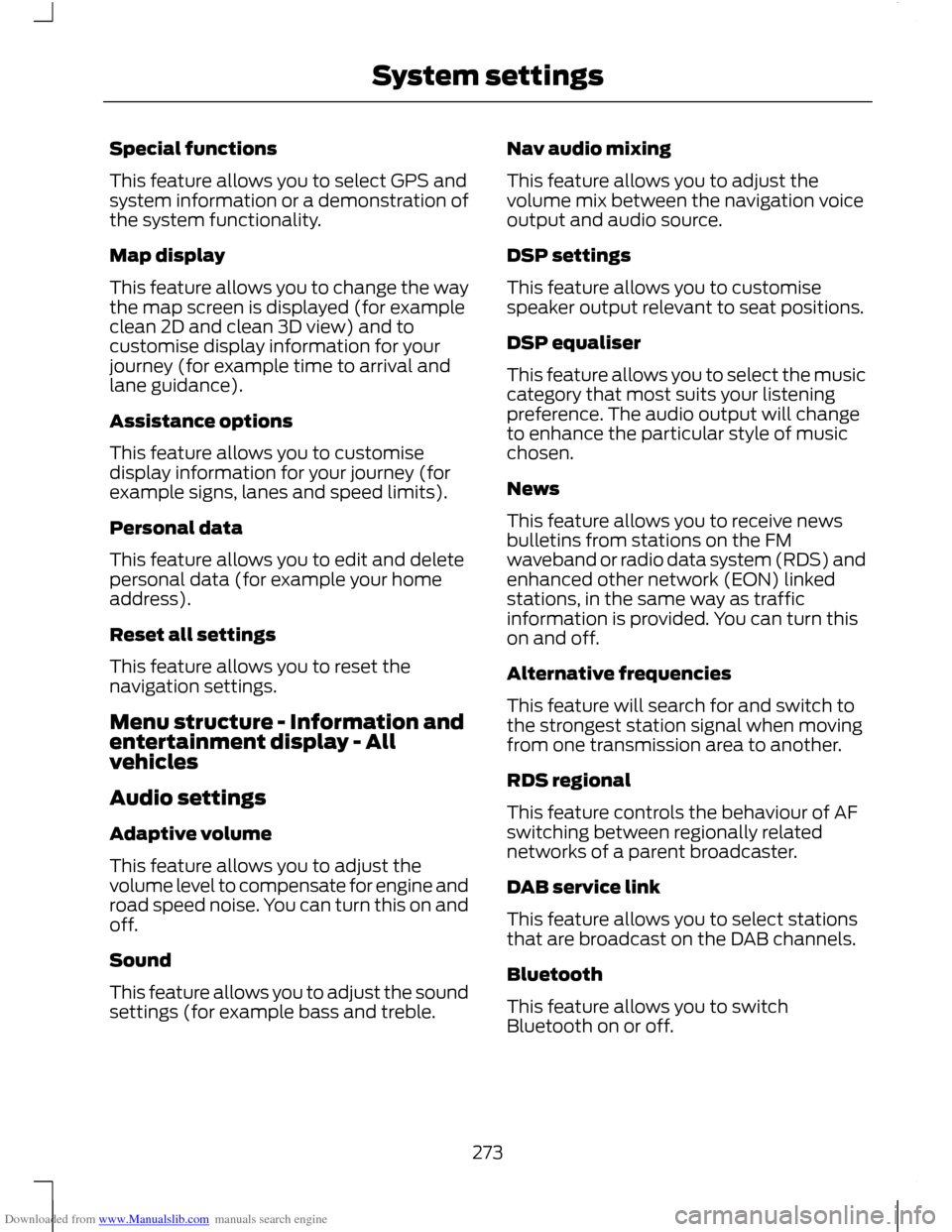
Downloaded from www.Manualslib.com manuals search engine Special functions
This feature allows you to select GPS and
system information or a demonstration of
the system functionality.
Map display
This feature allows you to change the way
the map screen is displayed (for example
clean 2D and clean 3D view) and to
customise display information for your
journey (for example time to arrival and
lane guidance).
Assistance options
This feature allows you to customise
display information for your journey (for
example signs, lanes and speed limits).
Personal data
This feature allows you to edit and delete
personal data (for example your home
address).
Reset all settings
This feature allows you to reset the
navigation settings.
Menu structure - Information and
entertainment display - All
vehicles
Audio settings
Adaptive volume
This feature allows you to adjust the
volume level to compensate for engine and
road speed noise. You can turn this on and
off.
Sound
This feature allows you to adjust the sound
settings (for example bass and treble.
Nav audio mixing
This feature allows you to adjust the
volume mix between the navigation voice
output and audio source.
DSP settings
This feature allows you to customise
speaker output relevant to seat positions.
DSP equaliser
This feature allows you to select the music
category that most suits your listening
preference. The audio output will change
to enhance the particular style of music
chosen.
News
This feature allows you to receive news
bulletins from stations on the FM
waveband or radio data system (RDS) and
enhanced other network (EON) linked
stations, in the same way as traffic
information is provided. You can turn this
on and off.
Alternative frequencies
This feature will search for and switch to
the strongest station signal when moving
from one transmission area to another.
RDS regional
This feature controls the behaviour of AF
switching between regionally related
networks of a parent broadcaster.
DAB service link
This feature allows you to select stations
that are broadcast on the DAB channels.
Bluetooth
This feature allows you to switch
Bluetooth on or off.
273
System settings
Page 276 of 296
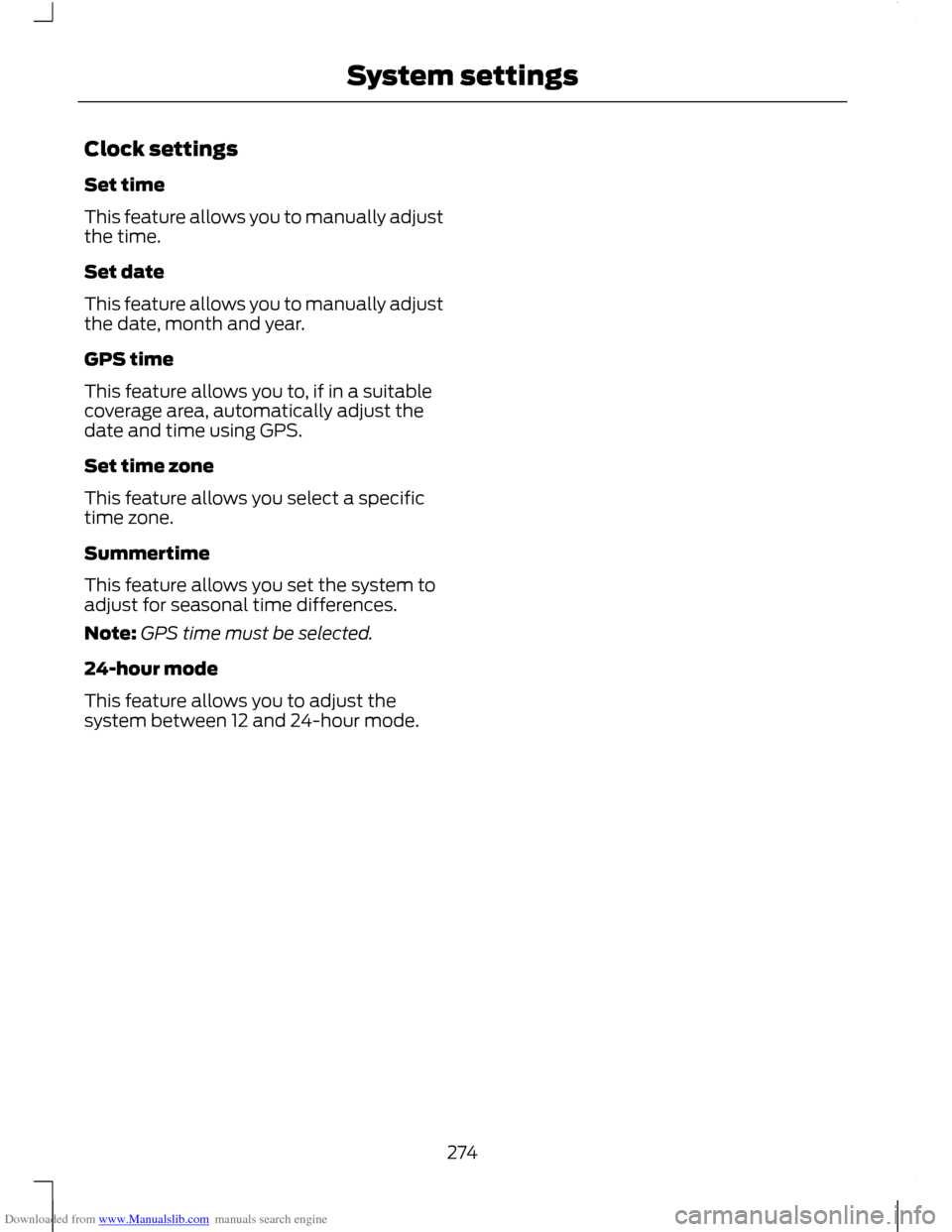
Downloaded from www.Manualslib.com manuals search engine Clock settings
Set time
This feature allows you to manually adjust
the time.
Set date
This feature allows you to manually adjust
the date, month and year.
GPS time
This feature allows you to, if in a suitable
coverage area, automatically adjust the
date and time using GPS.
Set time zone
This feature allows you select a specific
time zone.
Summertime
This feature allows you set the system to
adjust for seasonal time differences.
Note:
GPS time must be selected.
24-hour mode
This feature allows you to adjust the
system between 12 and 24-hour mode.
274
System settings
Page 277 of 296
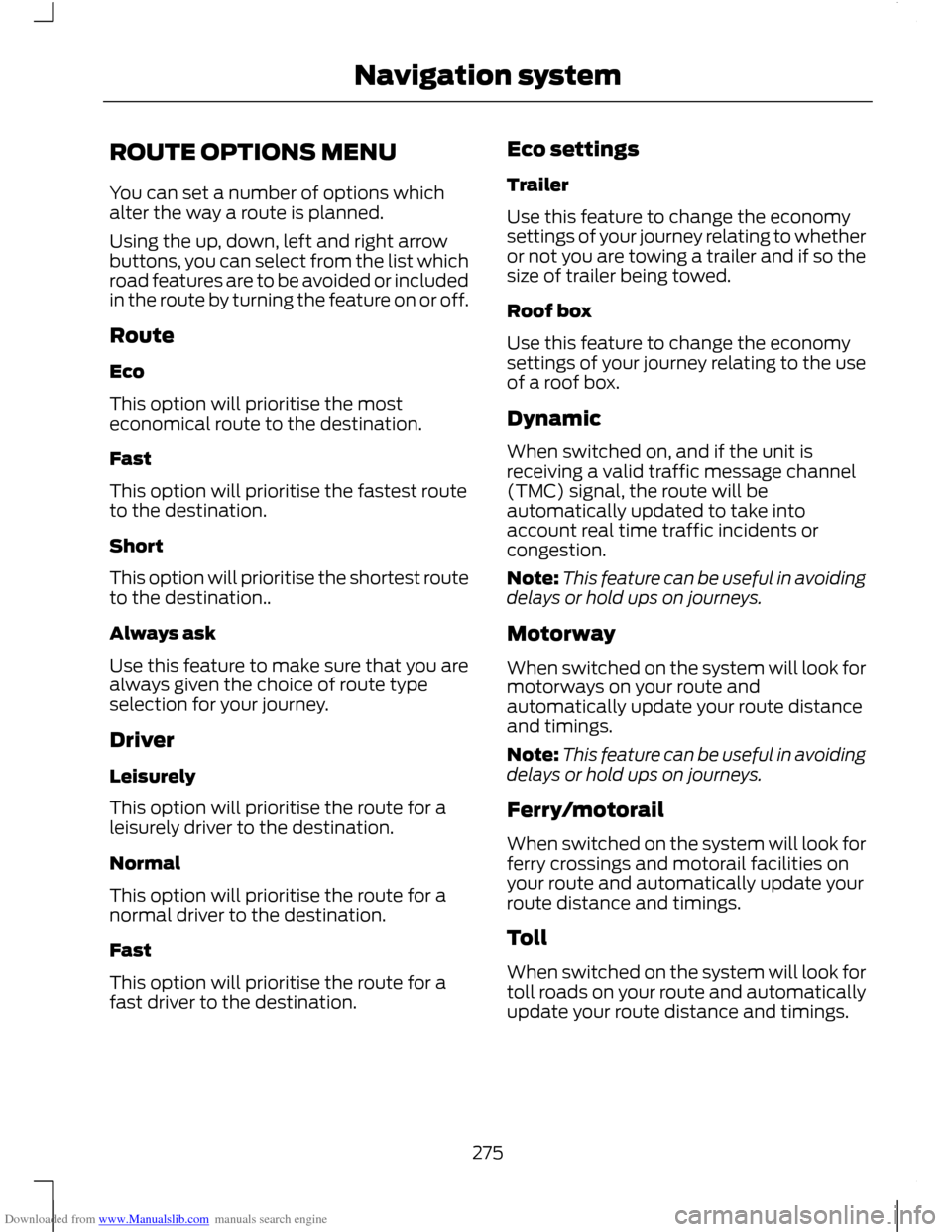
Downloaded from www.Manualslib.com manuals search engine ROUTE OPTIONS MENU
You can set a number of options which
alter the way a route is planned.
Using the up, down, left and right arrow
buttons, you can select from the list which
road features are to be avoided or included
in the route by turning the feature on or off.
Route
Eco
This option will prioritise the most
economical route to the destination.
Fast
This option will prioritise the fastest route
to the destination.
Short
This option will prioritise the shortest route
to the destination..
Always ask
Use this feature to make sure that you are
always given the choice of route type
selection for your journey.
Driver
Leisurely
This option will prioritise the route for a
leisurely driver to the destination.
Normal
This option will prioritise the route for a
normal driver to the destination.
Fast
This option will prioritise the route for a
fast driver to the destination.
Eco settings
Trailer
Use this feature to change the economy
settings of your journey relating to whether
or not you are towing a trailer and if so the
size of trailer being towed.
Roof box
Use this feature to change the economy
settings of your journey relating to the use
of a roof box.
Dynamic
When switched on, and if the unit is
receiving a valid traffic message channel
(TMC) signal, the route will be
automatically updated to take into
account real time traffic incidents or
congestion.
Note:
This feature can be useful in avoiding
delays or hold ups on journeys.
Motorway
When switched on the system will look for
motorways on your route and
automatically update your route distance
and timings.
Note: This feature can be useful in avoiding
delays or hold ups on journeys.
Ferry/motorail
When switched on the system will look for
ferry crossings and motorail facilities on
your route and automatically update your
route distance and timings.
Toll
When switched on the system will look for
toll roads on your route and automatically
update your route distance and timings.
275
Navigation system
Page 278 of 296
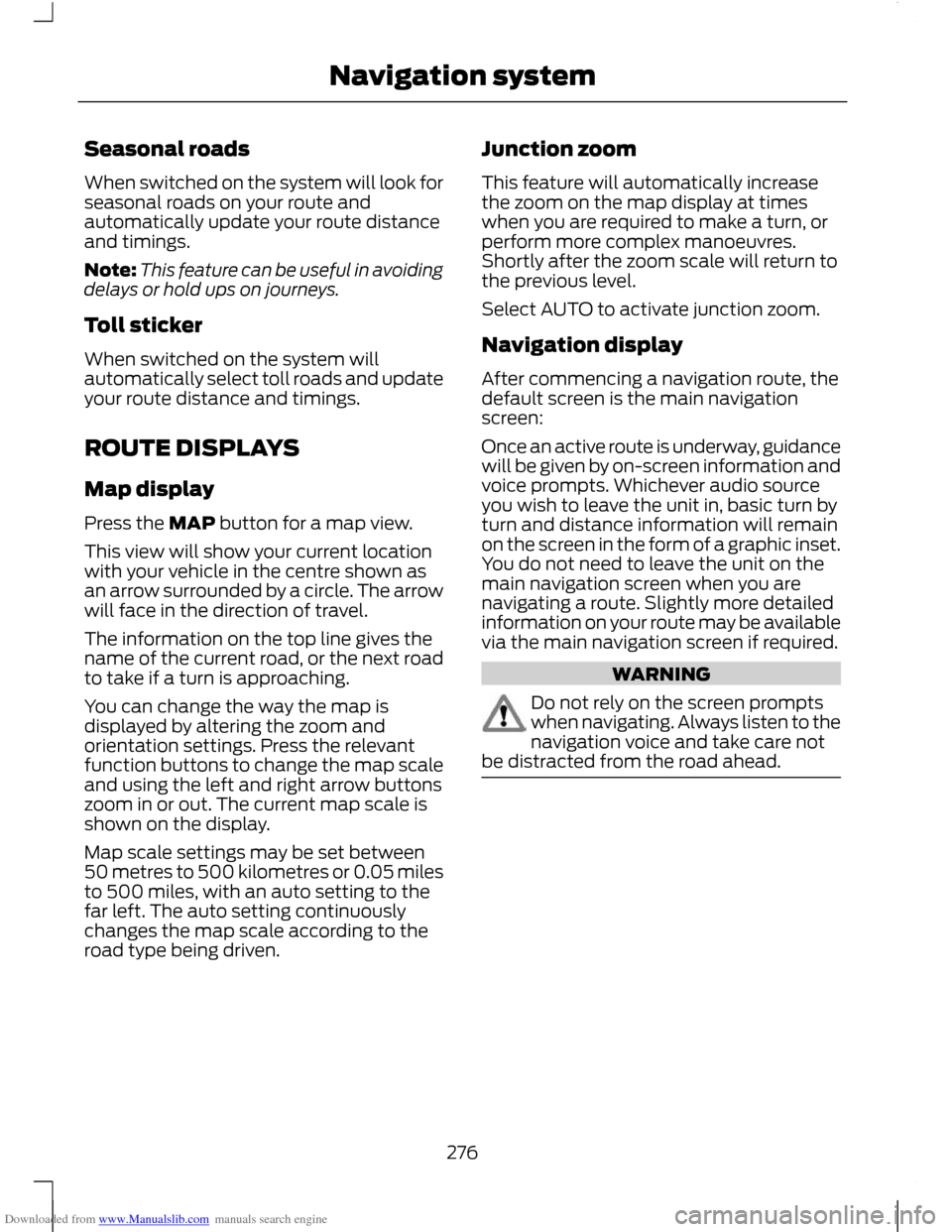
Downloaded from www.Manualslib.com manuals search engine Seasonal roads
When switched on the system will look for
seasonal roads on your route and
automatically update your route distance
and timings.
Note:
This feature can be useful in avoiding
delays or hold ups on journeys.
Toll sticker
When switched on the system will
automatically select toll roads and update
your route distance and timings.
ROUTE DISPLAYS
Map display
Press the MAP button for a map view.
This view will show your current location
with your vehicle in the centre shown as
an arrow surrounded by a circle. The arrow
will face in the direction of travel.
The information on the top line gives the
name of the current road, or the next road
to take if a turn is approaching.
You can change the way the map is
displayed by altering the zoom and
orientation settings. Press the relevant
function buttons to change the map scale
and using the left and right arrow buttons
zoom in or out. The current map scale is
shown on the display.
Map scale settings may be set between
50 metres to 500 kilometres or 0.05 miles
to 500 miles, with an auto setting to the
far left. The auto setting continuously
changes the map scale according to the
road type being driven. Junction zoom
This feature will automatically increase
the zoom on the map display at times
when you are required to make a turn, or
perform more complex manoeuvres.
Shortly after the zoom scale will return to
the previous level.
Select AUTO to activate junction zoom.
Navigation display
After commencing a navigation route, the
default screen is the main navigation
screen:
Once an active route is underway, guidance
will be given by on-screen information and
voice prompts. Whichever audio source
you wish to leave the unit in, basic turn by
turn and distance information will remain
on the screen in the form of a graphic inset.
You do not need to leave the unit on the
main navigation screen when you are
navigating a route. Slightly more detailed
information on your route may be available
via the main navigation screen if required.
WARNING
Do not rely on the screen prompts
when navigating. Always listen to the
navigation voice and take care not
be distracted from the road ahead. 276
Navigation system
Page 279 of 296
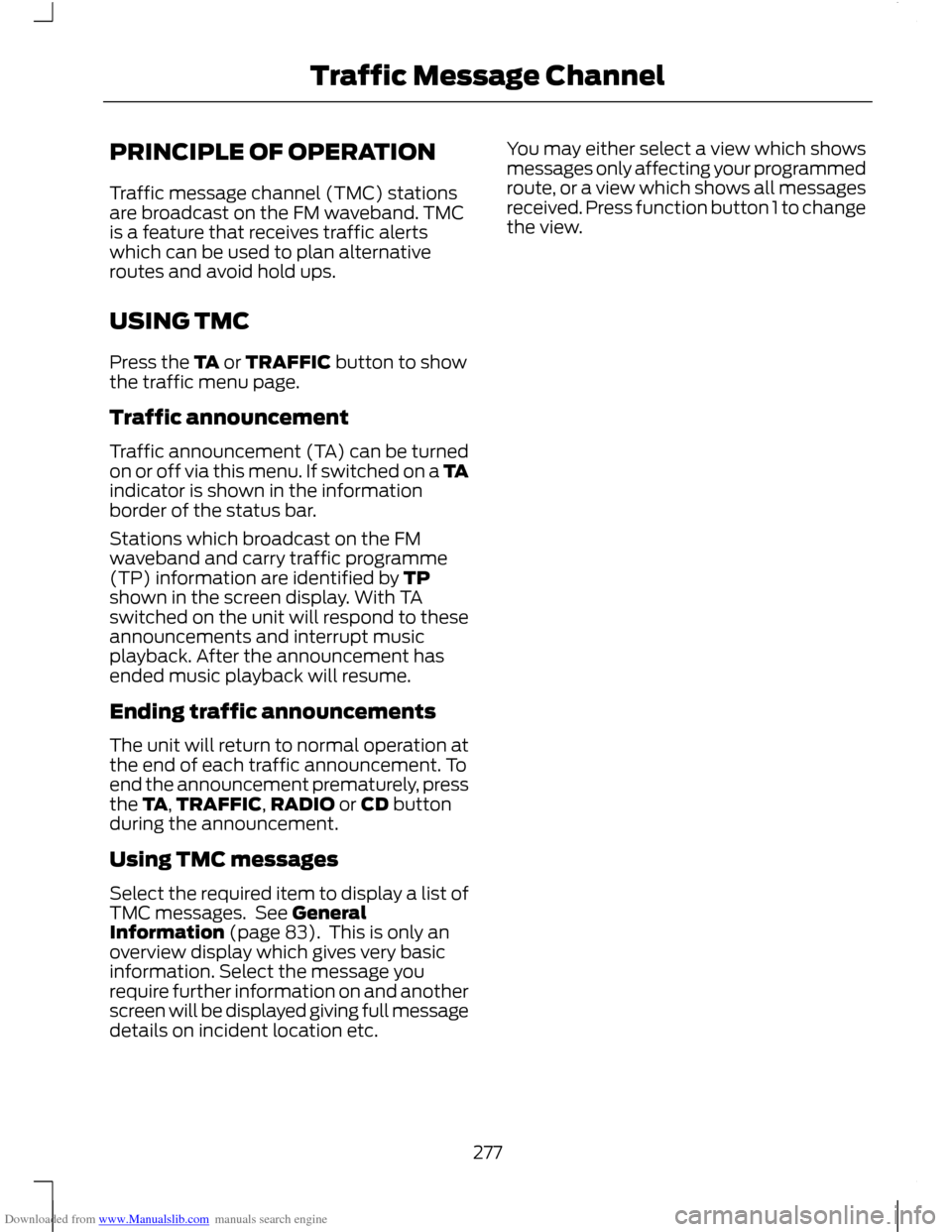
Downloaded from www.Manualslib.com manuals search engine PRINCIPLE OF OPERATION
Traffic message channel (TMC) stations
are broadcast on the FM waveband. TMC
is a feature that receives traffic alerts
which can be used to plan alternative
routes and avoid hold ups.
USING TMC
Press the TA or TRAFFIC button to show
the traffic menu page.
Traffic announcement
Traffic announcement (TA) can be turned
on or off via this menu. If switched on a TA
indicator is shown in the information
border of the status bar.
Stations which broadcast on the FM
waveband and carry traffic programme
(TP) information are identified by TP
shown in the screen display. With TA
switched on the unit will respond to these
announcements and interrupt music
playback. After the announcement has
ended music playback will resume.
Ending traffic announcements
The unit will return to normal operation at
the end of each traffic announcement. To
end the announcement prematurely, press
the TA,
TRAFFIC, RADIO or CD button
during the announcement.
Using TMC messages
Select the required item to display a list of
TMC messages. See General
Information (page 83). This is only an
overview display which gives very basic
information. Select the message you
require further information on and another
screen will be displayed giving full message
details on incident location etc. You may either select a view which shows
messages only affecting your programmed
route, or a view which shows all messages
received. Press function button 1 to change
the view.
277
Traffic Message Channel
Page 280 of 296
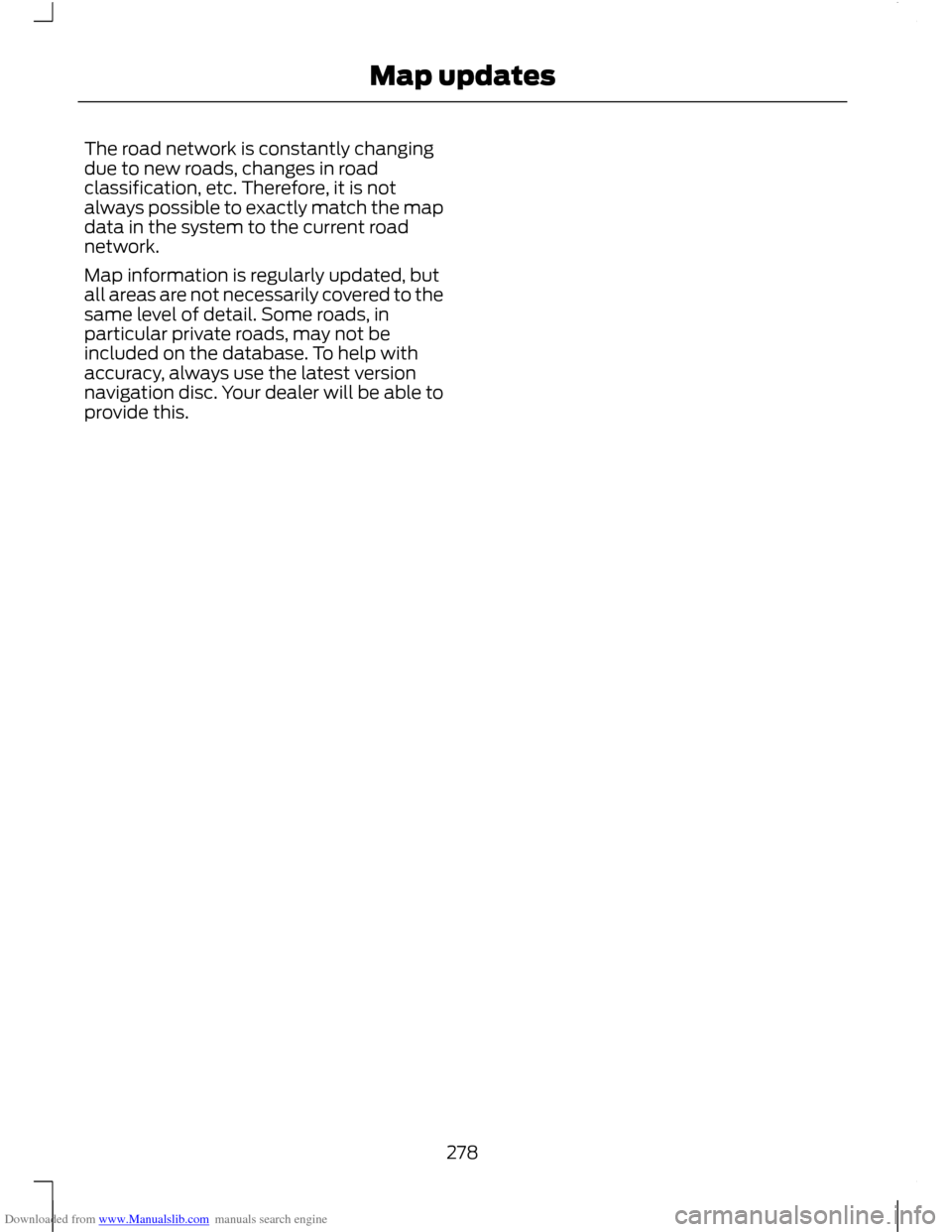
Downloaded from www.Manualslib.com manuals search engine The road network is constantly changing
due to new roads, changes in road
classification, etc. Therefore, it is not
always possible to exactly match the map
data in the system to the current road
network.
Map information is regularly updated, but
all areas are not necessarily covered to the
same level of detail. Some roads, in
particular private roads, may not be
included on the database. To help with
accuracy, always use the latest version
navigation disc. Your dealer will be able to
provide this.
278
Map updates